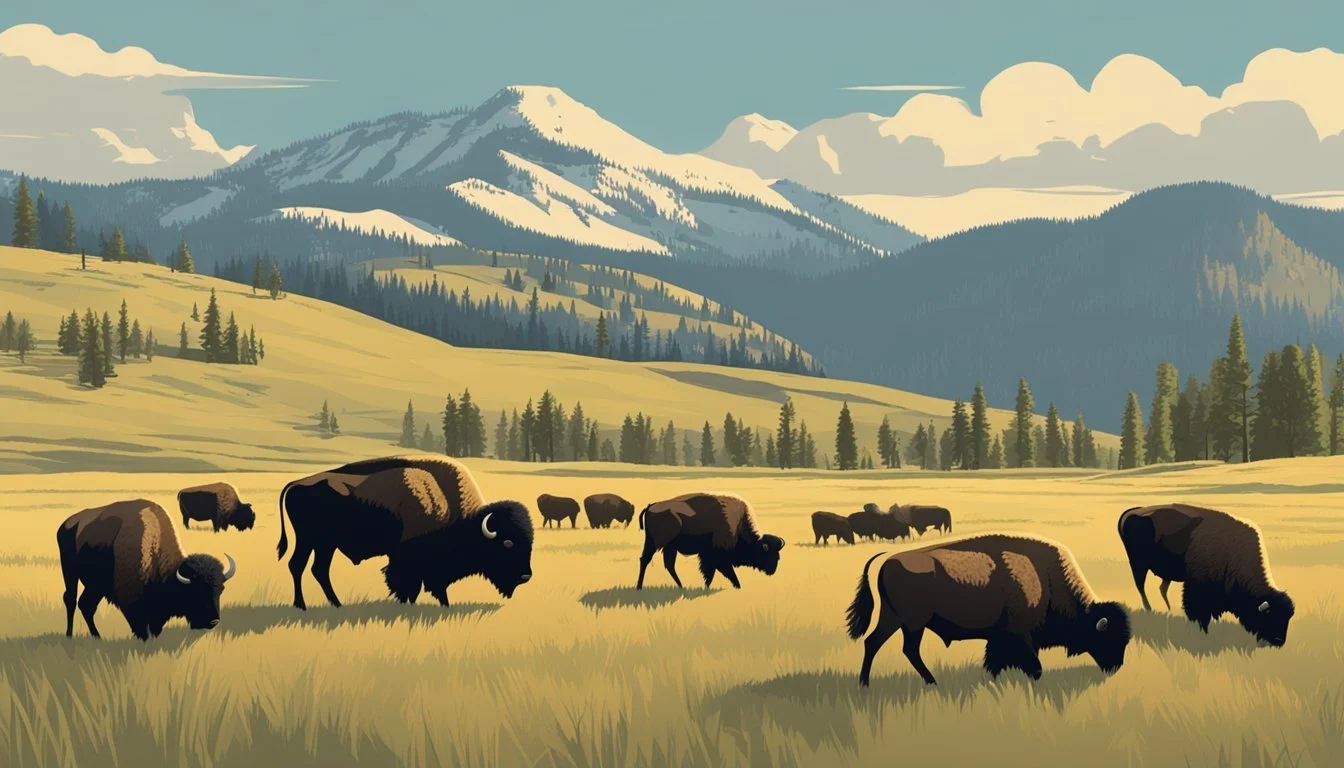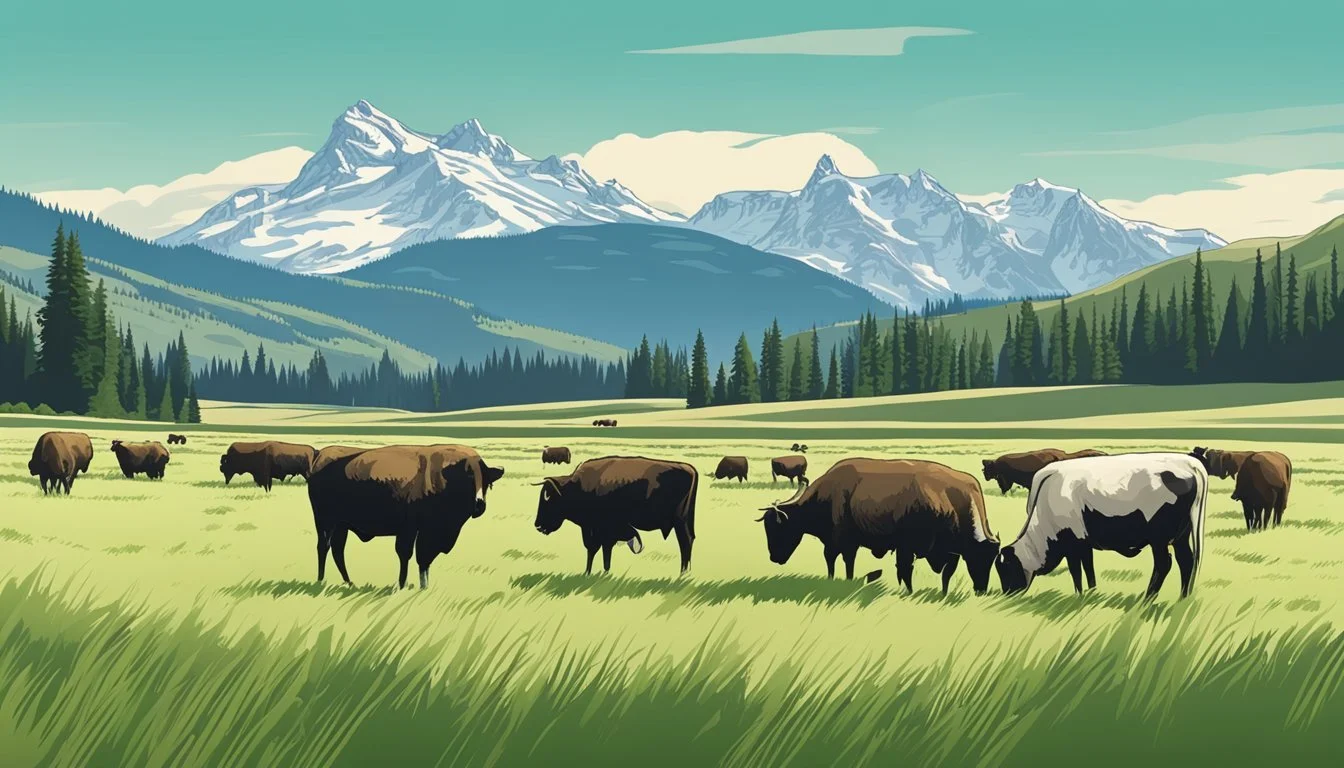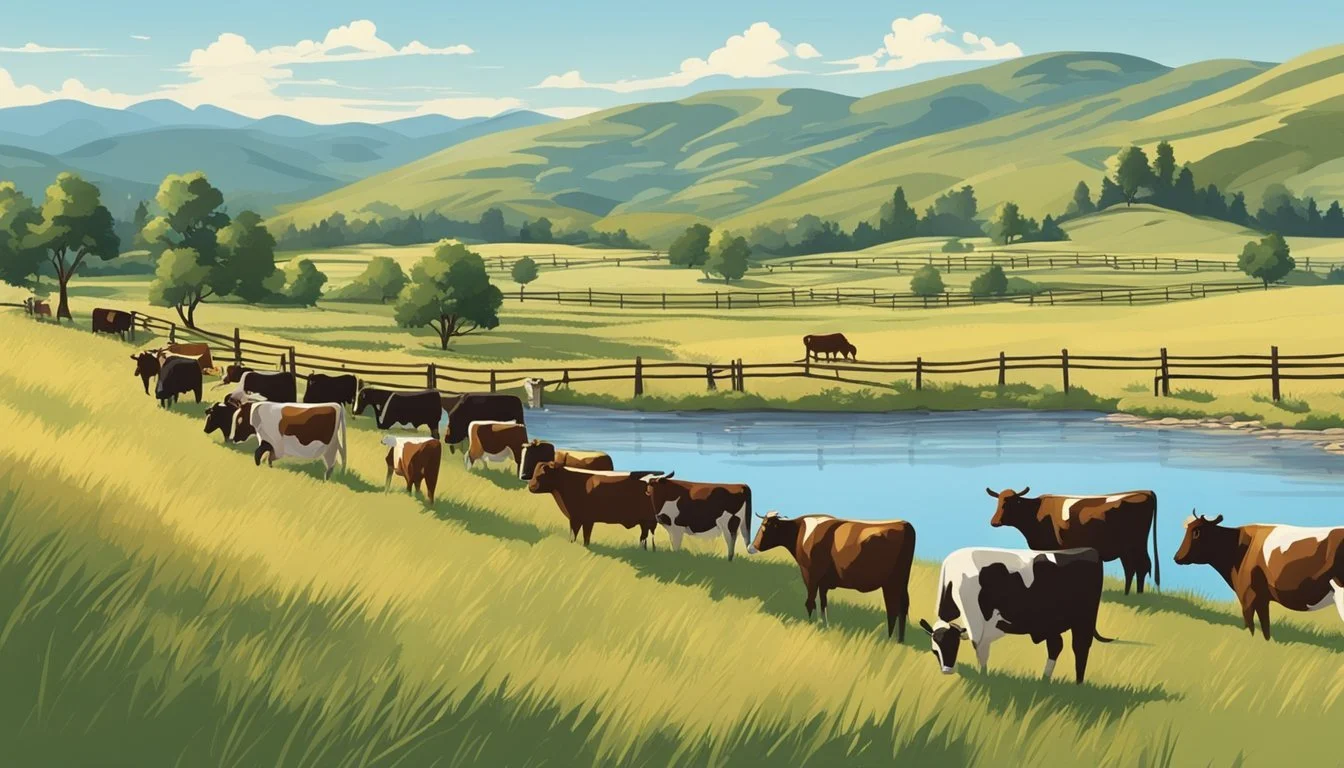Livestock in Yellowstone: More Than Just Ranch Scenery
Ecological Impact and Management Challenges
Yellowstone, the hit TV series, has captivated audiences with its portrayal of ranching life in Montana. The show's iconic Dutton Ranch, set against the stunning backdrop of Big Sky Country, serves as more than just scenery. It plays a crucial role in shaping the narrative and characters' motivations.
The livestock on the Yellowstone Ranch are integral to the story, representing both the Duttons' livelihood and their connection to the land. Cattle ranching forms the backbone of the family's operations, with herds grazing across vast expanses of Montana terrain. This authentic depiction of ranching life has resonated with viewers and even influenced perceptions of the industry.
While the Dutton Ranch is a fictional creation, it draws inspiration from real-life Montana ranches. The series is filmed on a working cattle ranch near Darby, Montana, adding an extra layer of authenticity to its portrayal of livestock management and the challenges faced by modern ranchers. This blend of fiction and reality has helped Yellowstone paint a compelling picture of the complex relationship between ranchers, their animals, and the land they steward.
The Significance of Yellowstone Ranch
The Yellowstone Ranch stands as a symbol of the American West, representing both a family legacy and a cultural touchstone. It embodies the spirit of ranching tradition while facing modern challenges.
Dutton Family and Their Heritage
The Dutton family has owned and operated Yellowstone Ranch for six generations. John Dutton, the current patriarch, leads the fight to preserve his family's legacy. The ranch represents more than just land and cattle - it's the embodiment of their history, values, and way of life.
Spanning thousands of acres, Yellowstone Ranch is the largest contiguous ranch in the United States. This vast expanse allows the Duttons to maintain a traditional ranching operation on a grand scale. The family's deep connection to the land is evident in their fierce protection of it against outside threats.
Financial pressures and changing times pose significant challenges to the ranch's survival. The Duttons face tough decisions, including potentially selling cattle to meet tax obligations. These struggles highlight the complex realities of modern ranching.
Cultural Symbolism of Yellowstone Ranch
Yellowstone Ranch symbolizes the enduring spirit of the American West. It represents a way of life that is increasingly rare in today's rapidly changing world. The ranch stands as a testament to the rugged individualism and self-reliance that characterized frontier life.
The iconic Yellowstone brand carries deep meaning beyond just marking cattle. It signifies loyalty, commitment, and belonging to the Dutton family and their way of life. For some ranch hands, receiving the brand is a rite of passage and a lifelong bond.
The ranch's struggles against development and modernization resonate with many viewers. It taps into broader cultural anxieties about the loss of traditional values and ways of life in the face of progress. This tension between old and new forms a central theme in the ranch's story.
Ranching Practices and Innovations
Ranching in the Yellowstone region has evolved significantly, blending traditional methods with modern sustainable approaches. These practices aim to balance livestock production with environmental stewardship.
Traditional vs. Modern Ranching Techniques
Early ranching relied heavily on open-range grazing and seasonal cattle drives. Fenced pastures gradually became more common to protect livestock and manage grazing areas more effectively.
Modern ranches utilize advanced technologies like GPS tracking and drones for herd management. These tools allow ranchers to monitor animal health and movement more efficiently.
Rotational grazing has gained popularity as a sustainable practice. This method involves moving cattle between different pastures to prevent overgrazing and promote grassland health.
Some ranches have adopted precision agriculture techniques. Soil sensors and satellite imagery help optimize hay production and pasture management.
Sustainable Livestock Management
Many Yellowstone area ranches now focus on sustainable practices to preserve the land for future generations. Water conservation is a key priority, with improved irrigation systems and strategic placement of water sources.
Regenerative grazing practices aim to improve soil health and increase carbon sequestration. This approach can help mitigate climate change impacts while enhancing pasture productivity.
Wildlife-friendly fencing designs allow for safer passage of native species like pronghorn and elk. These fences reduce injuries to both wildlife and livestock.
Some ranches have diversified their operations to include ecotourism. This provides additional income streams while showcasing sustainable ranching practices to visitors.
Ranching and Environmental Responsibility
Modern ranching practices are evolving to address environmental concerns while maintaining productivity. Ranchers are implementing innovative strategies to mitigate climate change impacts and enhance biodiversity on their lands.
Climate Change Adaptation Strategies
Ranchers are adopting various methods to adapt to changing climate conditions. Rotational grazing helps prevent overgrazing and promotes healthy grassland ecosystems. This practice allows pastures to regenerate, improving soil health and carbon sequestration.
Water management is crucial in drought-prone areas. Ranchers are installing efficient irrigation systems and creating water catchments to conserve this vital resource. Some are also planting drought-resistant forage crops to ensure feed availability during dry periods.
Many ranches are diversifying their operations to reduce climate-related risks. This includes incorporating agroforestry practices, which can provide shade for livestock and additional income streams.
Promoting Biodiversity Through Ranching
Well-managed rangelands can support diverse ecosystems. Ranchers are working to maintain native plant species, which provide habitat for wildlife and pollinators. Some are reintroducing native grasses to improve ecosystem health.
Fencing strategies are being implemented to protect sensitive habitats while allowing cattle to graze. Wildlife-friendly fences enable the movement of native species across the landscape.
Ranchers are also partnering with conservation organizations to protect endangered species. These collaborations often involve creating wildlife corridors and preserving critical habitats on ranch lands.
Integrated pest management reduces reliance on harmful chemicals, benefiting both livestock and native species. This approach emphasizes natural predator-prey relationships to control pest populations.
Economic and Social Challenges in Ranching
Ranching in Yellowstone faces complex economic pressures and social dynamics. Land disputes, financial struggles, and changing rural lifestyles create significant hurdles for ranchers trying to maintain their operations and way of life.
Navigating Land Ownership and Use Conflicts
Ranchers encounter growing tensions over land use and ownership. Increasing property values attract wealthy buyers and developers, driving up costs for traditional ranching families. This shift impacts local communities and alters long-standing social structures.
Public land grazing rights create another point of contention. Ranchers rely on these areas for livestock, but face opposition from conservation groups and government regulations. Balancing economic needs with environmental concerns proves challenging.
Water rights disputes further complicate ranching operations. Access to water sources is crucial for cattle and land management. Competing claims between ranchers, towns, and other stakeholders lead to legal battles and strained relationships.
The Human Cost of Ranching
Ranch life demands significant personal sacrifice. Long hours, physically demanding work, and exposure to harsh weather conditions take a toll on ranchers' health and well-being. Financial pressures add stress as ranchers navigate fluctuating market prices and slim profit margins.
Family dynamics often revolve around ranch operations. Children may feel pressure to continue the family business, potentially limiting their career options. Succession planning becomes a delicate balance of preserving tradition and allowing individual choices.
Isolation poses another challenge. Remote locations can limit social interactions and access to services. This isolation may contribute to mental health issues and feelings of disconnection from broader society.
Adapting to changing societal values presents additional hurdles. As public perceptions of animal welfare and land use evolve, ranchers must navigate new expectations while maintaining their livelihood and cultural identity.
Livestock in the Frame of Cowboy Culture
Livestock plays a central role in shaping cowboy culture and identity. The relationship between cowboys and their animals has defined ranch life for generations, creating unique traditions and skills.
The Evolution of American Cowboy Identity
The American cowboy emerged during westward expansion, influenced by Spanish vaqueros and the demands of cattle ranching. Cowboys developed specialized skills to manage large herds across vast open ranges. Their identity became intertwined with horses and cattle, as these animals were essential to their daily work and survival.
Horsemanship became a defining trait, with cowboys spending countless hours in the saddle. Cattle handling techniques evolved to efficiently move and care for livestock. Cowboys learned to read animal behavior, anticipate herd movements, and respond quickly to potential dangers.
The cowboy's attire also adapted to serve practical purposes. Wide-brimmed hats provided sun protection, while chaps protected legs from brush and rope burns. Boots with high heels prevented feet from slipping through stirrups.
Preserving Traditions in Modern Cowboy Life
Despite technological advancements, many aspects of traditional cowboy culture persist on modern ranches. Horseback riding remains crucial for navigating rugged terrain and managing cattle. Annual events like cattle drives and rodeos celebrate these enduring skills.
Ranchers still rely on time-honored practices for animal care, branding, and training young stock. Many take pride in preserving heritage breeds and sustainable grazing methods. The cowboy code of ethics - emphasizing hard work, loyalty, and respect for the land - continues to guide ranch operations.
Modern cowboys balance tradition with innovation. They may use GPS tracking for herd management or employ drones for land surveying. Yet the core relationship between cowboy and livestock remains at the heart of ranch life, ensuring the spirit of the American West lives on.
Influential Ranches: A Comparative Study
Iconic ranches like Yellowstone and King Ranch have shaped American agriculture and culture. Their legacies offer valuable insights into sustainable land management and livestock practices that continue to influence modern ranching.
Yellowstone vs. King Ranch: A Legacy Comparison
Yellowstone Ranch, featured prominently in popular media, spans vast acreage in Montana. It emphasizes traditional cattle operations while adapting to modern conservation needs. The ranch balances livestock production with wildlife preservation, setting standards for coexistence in sensitive ecosystems.
King Ranch in Texas covers 825,000 acres, nearly the size of Rhode Island. Founded in 1853, it pioneered cattle breeding programs and land stewardship practices. The ranch developed the Santa Gertrudis cattle breed, known for its heat tolerance and quality beef.
Both ranches have faced challenges from changing markets and environmental concerns. Their responses offer lessons in resilience and adaptation for the ranching industry.
Best Practices from Leading Ranches
Top ranches implement innovative strategies to maintain profitability and sustainability. Rotational grazing helps preserve grasslands and improve soil health. Many ranches diversify income streams through ecotourism, hunting leases, and specialty livestock products.
Water management is crucial. Leading ranches invest in efficient irrigation systems and water storage solutions. They also work to protect riparian areas, benefiting both livestock and wildlife.
Genetic improvement programs enhance herd quality and production efficiency. This includes selecting for traits like feed conversion, disease resistance, and meat quality.
Ranches increasingly embrace technology, using GPS tracking for herd management and drones for land surveys. These tools improve operational efficiency and environmental monitoring.
Portrayal of Ranching in Media and Realism
Television shows and movies often depict ranch life in dramatic ways that may not align with reality. Media portrayals can shape public perceptions of ranching, sometimes creating misconceptions about the industry.
Accuracy of Ranch Life Depictions
Popular shows like Yellowstone present a heightened version of ranch life. While they capture the rugged spirit, they often exaggerate conflicts and daily activities. Real ranches typically employ fewer workers than shown on screen.
The Dutton family's struggles in Yellowstone are more intense than what most ranchers face. Actual ranchers deal with economic pressures and environmental challenges, but rarely encounter the life-or-death situations depicted in the show.
Modern ranching involves technology and sustainable practices not often portrayed in media. Many ranchers use GPS tracking for livestock and implement conservation methods to protect land resources.
Impact of Media on Public Perception of Ranching
Media representations can romanticize ranch life, leading to unrealistic expectations. Some viewers may believe ranching is filled with constant action and drama, overlooking the day-to-day realities of the profession.
Shows like Yellowstone have increased interest in ranch tourism and lifestyle. This attention can benefit rural economies but may also lead to misunderstandings about ranching practices.
Accurate portrayals in documentaries or educational programs can help bridge the gap between fiction and reality. These productions offer insights into the economic and environmental aspects of modern ranching.
Media depictions influence public opinion on land use and conservation issues. Balanced representations are crucial for fostering informed discussions about the role of ranching in contemporary society.







